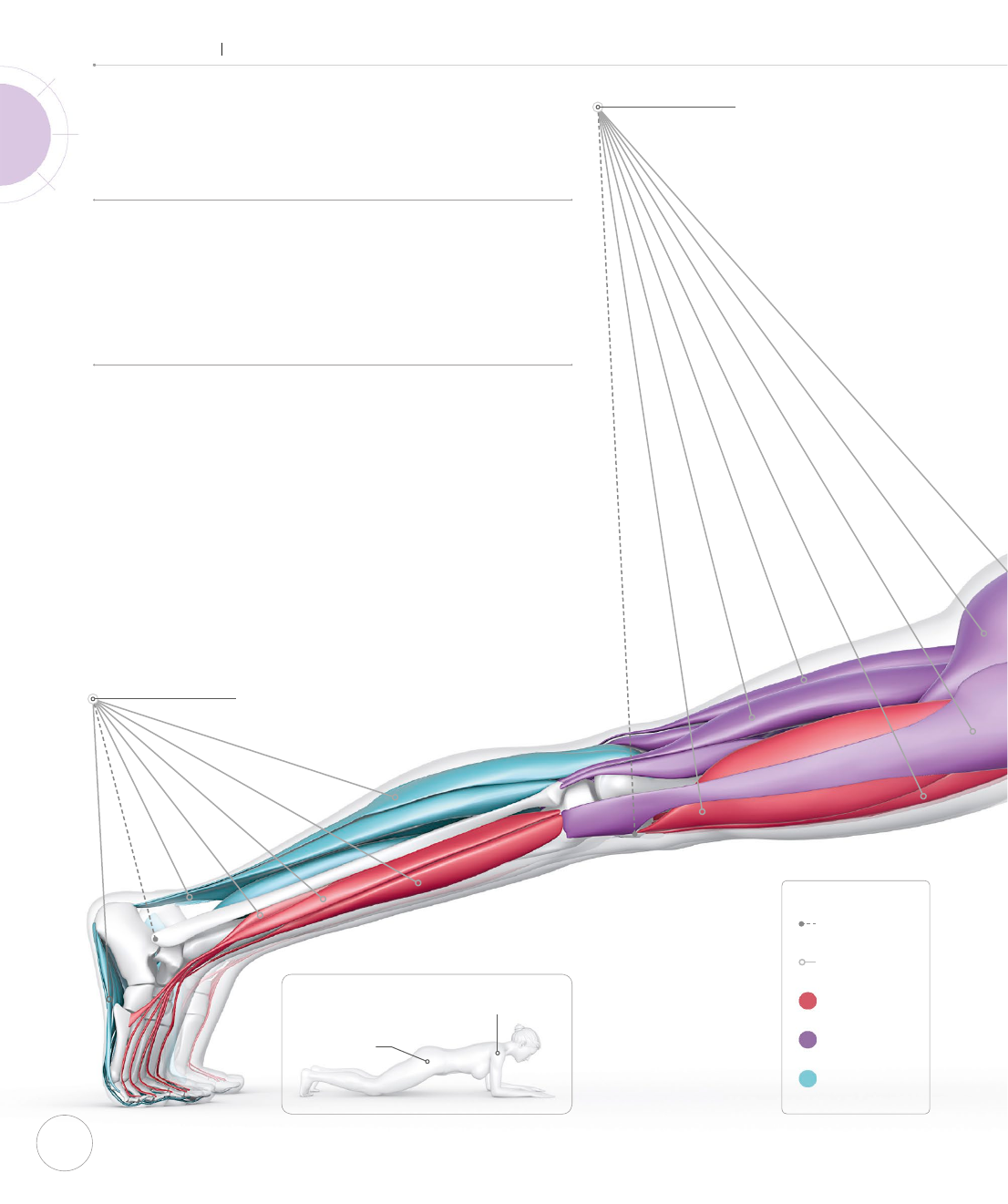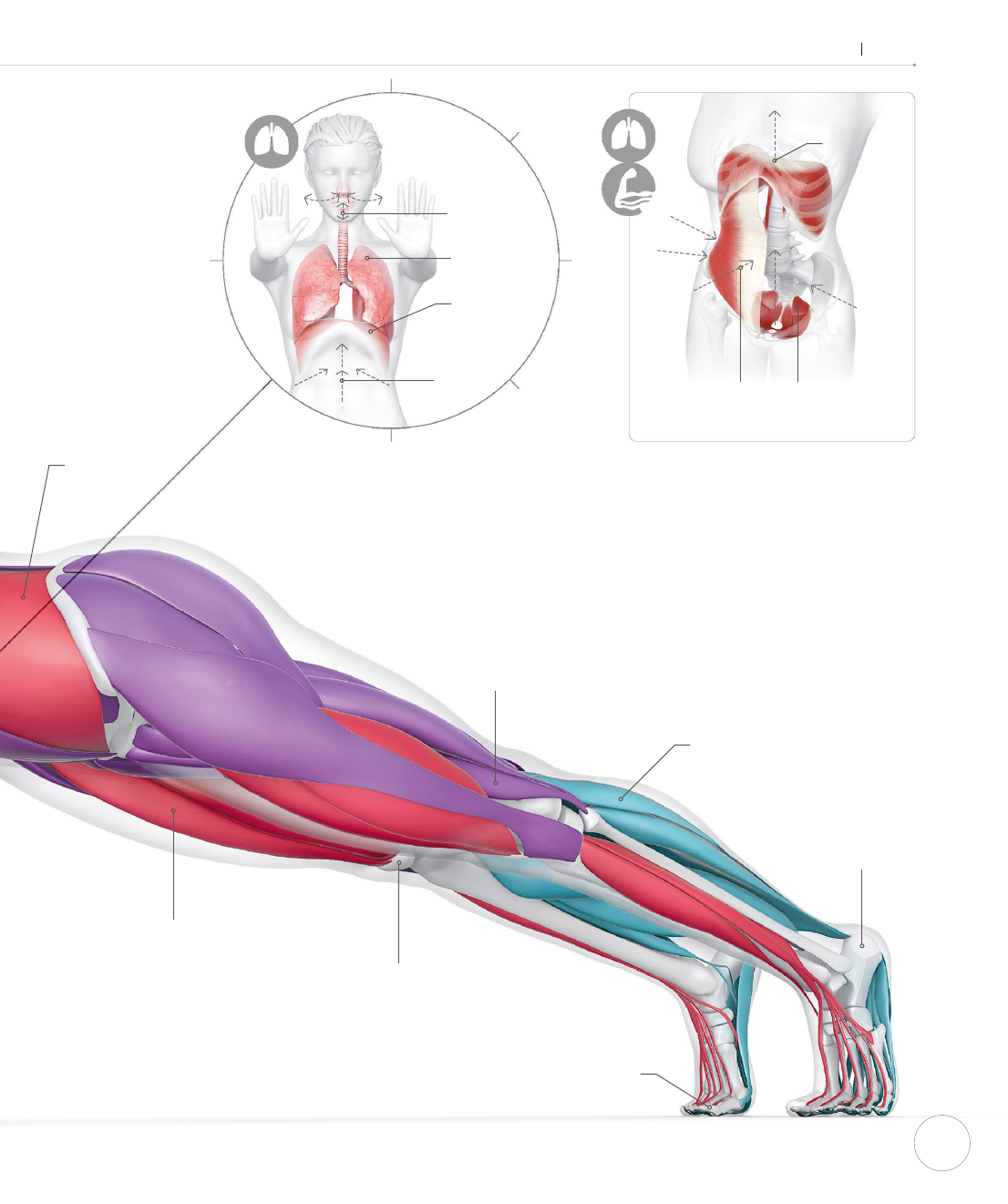
150
THE ASANAS
Floor
Plank pose is the top point of a press up. It is a
strong, stabilizing pose that works muscles from
the deepest layers inside you to the most supercial.
When holding Plank you are giving your body a
thorough, strengthening workout.
THE BIG PICTURE
Plank pose particularly strengthens your shoulders and entire
core—including your abdominals, back muscles, and pelvic
floor muscles. It builds heat and energy throughout your
body when held for several breaths or more.
PLANK
Kumbhakasana
Thighs
Your quadriceps engage to
extend your knees and stabilize
your thighs. Your hip adductors
and abductors engage while in
a neutral position to stabilize
your thighs and hips.
Lower legs
Your ankle dorsiexors engage
as you press your heels back. You
are likely to feel a stretch in your toe
exors and in the plantar region of
your foot. Your calf muscles are in
a slightlly stretched position.
VARIATION
Place your forearms and,
optionally, knees down to
lower the intensity. Don’t
allow your back to sag—if
you feel any strain on
your back come out of
the pose and rest.
Shoulders and
elbows in lineHips
forward
of knees
Soleus
Plantar fascia
Gastrocnemius
Tibilias anterior
Extensor digitorum longus
Extensor hallucis longus
Ankle
Gluteus medius
Gluteus maximus
Tensor fasciae latae
Knee
Semitendinosus
Biceps femoris
Vastus lateralis
Rectus femoris
KEY
Joints
Muscles
Engaging
Engaging while
stretching
Stretching
US_150-151_Plank_01.indd 150 28/09/2018 17:08

151
Neck
Your upper trapezius and
cervical extensors engage to
stabilize your neck, resisting
gravity’s pull to drop the head
forward. In this version, your
cervical exors engage to
tuck the chin slightly.
Arms
Your rotator cu muscles and
deltoids dynamically engage to
stabilize your scapulae and shoulders.
The triceps extend your elbows, while
your pronators help to pronate your
forearms. Your wrist extensors engage,
while your wrist exors stretch.
Torso
The abdominals engage to compress
your abdominal organs. Your spinal
extensors engage to resist gravity,
bringing your spine into neutral. Your
pectoralis major muscles engage
to adduct and ex your shoulders.
ALIGNMENT
Your hands are under your shoulders or slightly
forward. Without moving your hands, pull them
back toward your feet to engage your core. Imagine
a diagonal line from your heels to your head.
Hands under
shoulders, press
down and back
Crown of
head reaches
forward
Spine neutral,
core engaged
Feet hip-
distance apart
Elbows
soft, not
locked
Press heels
back
Rectus abdominis
Obliques
Spinal extensors
Serratus anterior
Spine
Triceps brachii
Deltoids
Biceps brachii
Elbow
Palmaris longus
Flexor carpi ulnaris
Extensor carpi ulnaris
Extensor carpi radialis brevis
Extensor carpi radialis longus
Brachioradialis
Sternocleidomastoid
Splenius muscles
Upper trapezius
US_150-151_Plank_01.indd 151 20/09/2018 21:10

152
PLANK
Kumbhakasana
Jalandhara bandha
Jalandhara means “net holding”
in Sanskrit; the bandha is so called
because shermen in ancient India
would hold nets under their chins.
This pose engages your neck
muscles in a subtle but similar
way as you lift your head up against
gravity. Traditionally, this is done
while seated, and with the glottis
closed for breath retention
(kumbhaka). However, you should
keep breathing while in plank.
Three diaphragms
Some researchers describe the three areas of the
bandhas as the “three diaphragms,” shown on
the image above. According to this model, these
three oscillate between engagement and release
freely in a healthy breath.
CLOSER LOOK
Plank can be used to explore yogic
energetic locks, called bandhas. In
this version, notice subtle activation
in the areas of the bandhas while
breathing. You can practice engaging
the bandhas under instruction
from a qualified teacher.
Serratus anterior
muscles engage
to prevent your
shoulder blades
from winging out
Thoracic outlet
diaphragm
(including the
neck and thorax
muscles and
the glottis)
Respiratory
diaphragm
Abdominals move
freely with breath
Pelvic floor
diaphragm
Wrists are
extended
Crown of the head
reaches forward
Splenius muscles
Longus muscles
Sternocleidomastoid
Rotator cu
muscles engage
to stabilize
shoulders
US_152-153_Plank_02.indd 152 02/11/2018 14:05

153
THE ASANAS
Floor
Uddiyana bandha
Uddiyana bandha involves engagement
of the abdominal muscles to pull the belly
in, and diaphragm up, with the exhale, and
often incorporates a breath hold. In this pose,
you are only doing a subtle version of this,
but drawing your abdominals in and up
while still breathing.
Mula bandha
Mula means “root” in Sanskrit; this bandha
involves a pelvic oor engagement. When your
transversus abdominis or “corset muscles”
engage, your pelvic oor also naturally engages.
Notice if you feel a lift (in this case, horizontally) in
your pelvic oor, particularly with your exhales.
This is soft and subtle; don’t squeeze.
Heels press
back
Quadriceps work
to hold legs in
extended position
Knees extended
but not locked
Toes are
curled under
Diaphragm
Lungs
Abdominals
drawn in
and up
Transversus
abdominis
(corset muscles)
Pelvic floor
muscles
Diaphragm
ascends with
exhales
Keep
breathing
steadily in
this pose
ANTERIOR–LATERAL VIEW
Calf muscles
stretch as heels
press back
Hamstrings
lengthen and
engage slightly
to stabilize
Deep core
muscles engage
to support torso
US_152-153_Plank_02.indd 153 20/09/2018 21:10
..................Content has been hidden....................
You can't read the all page of ebook, please click here login for view all page.
